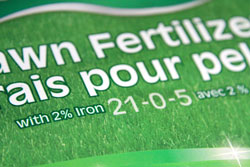Autumn is the time when plants put on lots of root growth, and this is where potassium comes in. It’s the last of three numbers in the fertilizer analysis figure. Fall fertilizing increases your lawn’s ability to survive the winter, and sets the stage for healthy growth next spring.
Fertilizer Nutrients and What They Do
 The first number of a fertilizer analysis is the percentage of nitrogen delivered. Nitrogen is responsible for lush, green growth. Pale green or yellow foliage can be caused by a lack of nitrogen, but beware. Too much nitrogen will prevent flowering plants from developing blooms.
The first number of a fertilizer analysis is the percentage of nitrogen delivered. Nitrogen is responsible for lush, green growth. Pale green or yellow foliage can be caused by a lack of nitrogen, but beware. Too much nitrogen will prevent flowering plants from developing blooms.
Phosphorous is represented by the second analysis number, and plants use this element to establish new roots. It’s especially important that young plants have an abundance of phosphorus.
The third number tells you how much potassium a fertilizer contains. Potassium is essential for plant vigor and disease resistance.
Soil Acidity and Fertility
Nutrients are one thing, but something called soil pH can affect how easily these nutrients are available to plants. pH is a number scale that measures how acidic or alkaline something is. A pH of 7.0 is neutral. Numbers below this are acidic, and numbers higher are alkaline. A soil of 6.5 to 7.0 pH is ideal for lawns and general purpose flower and vegetable gardens, and results in the greatest soil nutrient availability to plants. A few plants that require acidic conditions include azaleas, blueberries, tomatoes and hibiscus. A good soil test will tell you the pH of what you’ve got. Most soils that require amendment are too acidic. Adding crushed limestone will increase pH and introduce calcium to the soil, which is a good thing. By contrast, adding powdered sulphur to soil is the best option for lowering pH when specific plants need it. Interestingly, hydrangeas develop blue flowers when soil conditions are acidic, and the same plants will bloom pink when growing in alkaline soils with sufficient nutrients.
Read “Understanding the Basics of Lawn and Garden Fertilizers” for more on fertilizing your lawn.



